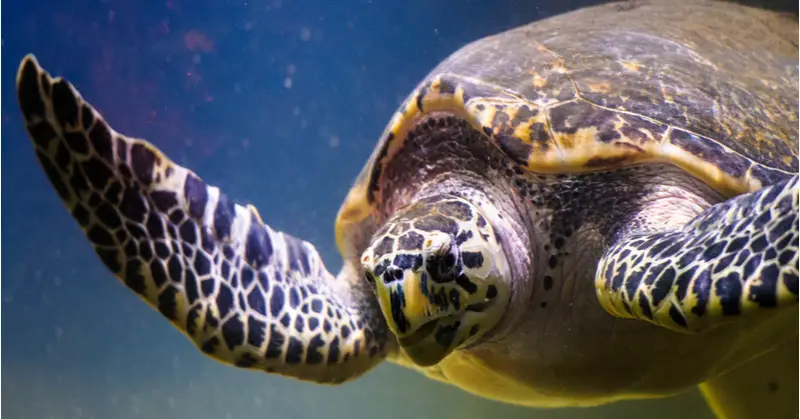
Realizing they were sitting on a mountain of data, NOAA Fisheries researchers sifted through location and dive records of satellite-tracked sea turtles, as well as weather buoy data along a stretch of the Mid-Atlantic that had been gathered as a hurricane tracked its way through the sea turtles’ seasonal territory.
As Leah Crowe, a biologist with the team said, “Hurricanes are some of the most intense weather events loggerheads in the mid-Atlantic experience, and we thought it was worth investigating how turtles in our dataset may be influenced by these dramatic environmental changes.”1 The result is a better understanding of how sea turtles navigate their way through the punishing waters of a hurricane.
The researchers are based at the Northeast Fisheries Science Center at Woods Hole, Massachusetts, and nearby Coonamessett Farm Foundation. They have tagged over 200 loggerhead sea turtles since 2009. In June 2011, they tagged 26 loggerheads along a Mid-Atlantic stretch between Virginia and New Jersey, just two months before Hurricane Irene tore its way up the coast.
The loggerheads had been fitted with sophisticated satellite relay tags that transmitted not only the location and depth of the sea turtles, but also the temperatures of both the sea-surface and ocean depths where the turtles swam. The weather buoy system collects wind direction, speed, gust, significant wave height, swell and wind-wave heights and periods, air temperature, water temperature, and sea level pressure.2 On top of that, the team used data from NOAA’s unmanned “autonomous gliders” that are a little fleet of underwater vehicles that can be deployed in the ocean for months at a time, rising and sinking to measure ocean temperature, salinity, and even do acoustic monitoring.3

What did the researchers find out about the behavior of the 18 loggerheads who were swimming in the direct path of Hurricane Irene? NOAA summed it up this way:
“Perhaps in an effort to conserve energy, the majority of turtles aligned themselves with the surface currents and moved northward during the hurricane.” After the hurricane, scientists observed that turtles that remained in their pre-storm foraging grounds maintained extended dive durations. Certain dives lasted an hour or longer, whereas the average dive duration prior to the typhoon was less than thirty minutes[1].
“In accordance with their typical seasonal movements, the turtles that abandoned their foraging grounds after the hurricane passed passed south earlier than anticipated.” Furthermore, this transition occurred over a month prior to the customary seasonal decline in water temperature, which coincides with the conclusion of the foraging season for loggerhead turtles in that particular area of the Mid-Atlantic region [1].
Leah Crowe made this observation about the bigger picture for sea turtles and large storms: “It is necessary to examine the long-term cumulative effects of a changing climate and the intensification of hurricanes and other storms.” Behavioral and spatial fluctuations of sea turtles can have an impact on population estimates and management choices…This study serves as a reminder that turtles inhabit a dynamic environment, and it is unwise to presume that their behavior will remain constant across time and space.”[1].
You can read the complete research paper about this fascinating project here. No surprise that they entitled it, “Riders on the Storm”!4
—R.A. Kroft
Sources
1NOAA Fisheries. Loggerhead Turtles Record a Passing Hurricane. News. 26 August 2020.
2National Data Buoy Center. What is Dial-A-Buoy? NOAA website.
3National Ocean Service. Ocean Gliders: How NOAA Uses Autonomous Technology to Help Predict Hurricane Intensity. NOAA Ocean Podcast, Episode 26.
4Crowe LM, Hatch JM, Patel SH, Smolowitz RJ, Haas HL. Riders on the storm: loggerhead sea turtles detect and respond to a major hurricane in the Northwest Atlantic Ocean. Movement Ecology, 2020; 8 (1) DOI: 10.1186/s40462-020-00218-6.
—
R.A. Kroft writes about her day-to-day journey in living a smaller, more sustainable life and other topics that interest her.

This Site Was Inspired By An Interest in Protecting the Environment:
We had the privilege and joy of learning from Dr. Charlie Stine who instilled a love for the natural world through incredible field trips with the Johns Hopkins Odyssey Certificate program in Environmental Studies. At the time, the program was endorsed by the Maryland Department of Natural Resources. Sadly, after Dr. Stine retired, the program was phased out. We hope that we honor his legacy by shining a bright light on environmental issues and sharing good news about the success of various conservation programs when possible.
